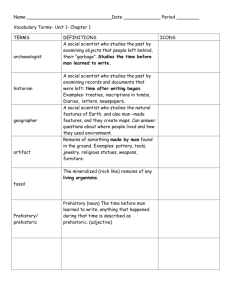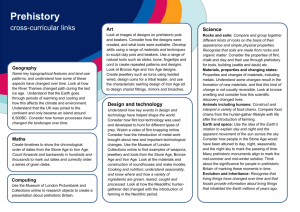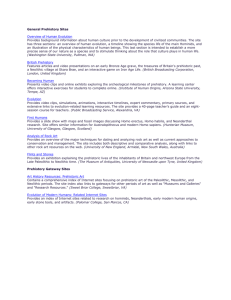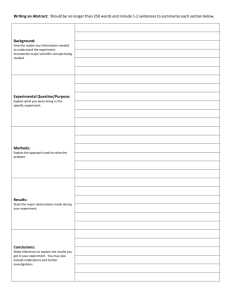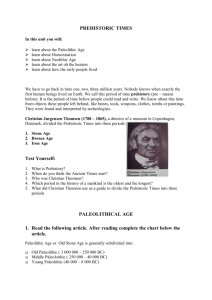The first people in europe
advertisement
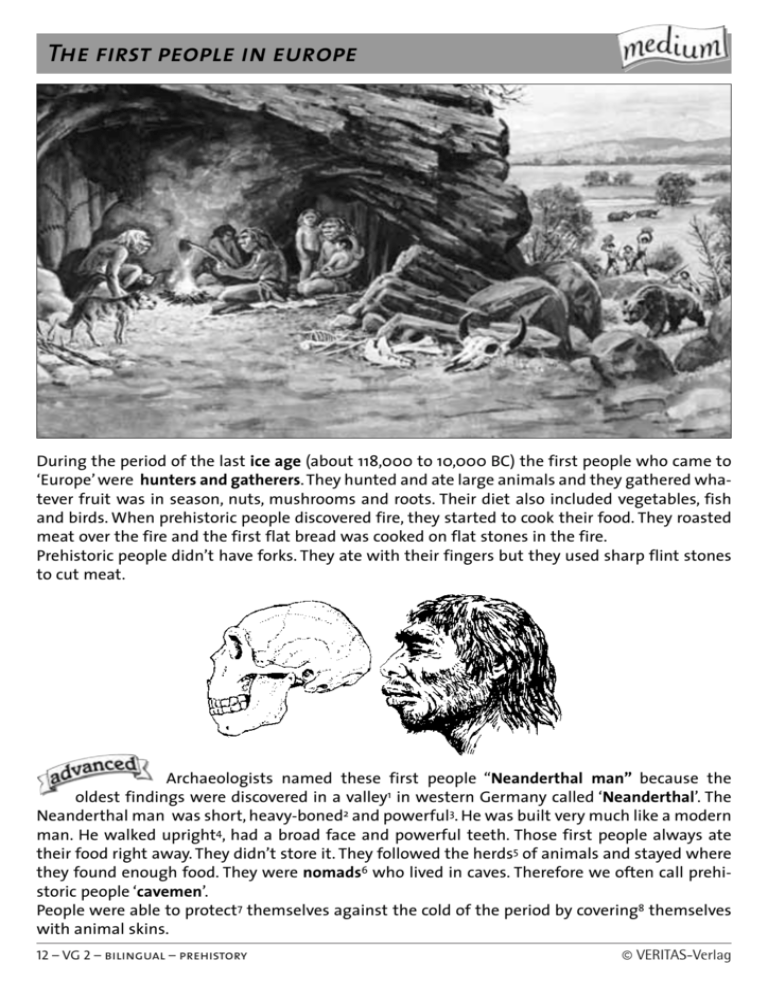
The first people in europe During the period of the last ice age (about 118,000 to 10,000 BC) the first people who came to ‘Europe’ were hunters and gatherers. They hunted and ate large animals and they gathered whatever fruit was in season, nuts, mushrooms and roots. Their diet also included vegetables, fish and birds. When prehistoric people discovered fire, they started to cook their food. They roasted meat over the fire and the first flat bread was cooked on flat stones in the fire. Prehistoric people didn’t have forks. They ate with their fingers but they used sharp flint stones to cut meat. Archaeologists named these first people “Neanderthal man” because the oldest findings were discovered in a valley1 in western Germany called ‘Neanderthal’. The Neanderthal man was short, heavy-boned2 and powerful3. He was built very much like a modern man. He walked upright4, had a broad face and powerful teeth. Those first people always ate their food right away. They didn’t store it. They followed the herds5 of animals and stayed where they found enough food. They were nomads6 who lived in caves. Therefore we often call prehistoric people ‘cavemen’. People were able to protect7 themselves against the cold of the period by covering8 themselves with animal skins. 12 – VG 2 – bilingual – prehistory © VERITAS-Verlag Lexis Read the text about THE FIRST PEOPLE IN EUROPE carefully and try to remember: What did people eat? x2 What did people wear? x4 Where and how did people live? x6 What did people look like? x8 What work did people do? x9 Multiply the number of answers by the numbers next to the questions and add the results. Check the final number with the solution on the answer page. hunt gatherers nuts powerful teeth caves fruit roots fish meat powerful flat bread animal skins heavy-boned upright vegetables birds mushrooms short nomads SOLUTION: Why do modern people call me a ‘caveman’? Write a list of German/English words. Translate the words in the word chain: AU FR EC HTFISC H FLEISC HGEMÜSEKRÄFTIGEZÄH N EHÖH LENJAGDKU RZKRAFT VO L LS C H W E R K N O C H I G N OM A D E N KU C H E N = F L A D E N B ROTN Ü S S E O B STP I L Z E SAMMLERTIERHÄUTEVÖGELWURZELN © VERITAS-Verlag VG 2 – bilingual – prehistory – 13 Words in context Use page 12 and the German/English wordlist on page 11 to complete the sentences: 1. The first people who came to ‘Europe’ were . . . . . . . . . . . . and . . . . . . . . . . . . . 2. The Neanderthal man was . . . . . . . . . . . . , heavy- . . . . . . . . . . . . and . . . . . . . . . . . . 3. He walked . . . . . . . . . . . . , had a . . . . . . . . . . . . face and powerful . . . . . . . . . . . . 4.The Neanderthal man hunted large animals and ate his . . . . . . . . . . . . 5. These early people gathered and ate . . . . . . . . . . . . . . . . . . . . . . . . . . . . . . . . . . . . 6.Being nomads, they followed the herds and mostly lived in . . . . . . . . . . . . Look at the picture on page 12. True or false? (Solution: see the answer page) Prehistoric people didn’t cook their food. They ate with their fingers and didn’t have forks. The Neanderthal man made ‘knives’ from flint stones. The first people stored their food in caves. They made clothes from animal skins. They were already able to use fire. There’s a bear which lives in caves. There are three rhinoceros. Two men are roasting meat. Four men are frightening the bear to keep it away from the cave. It is winter. There are two children in the picture. Follow the lines and find more words: BC findings discover before Christ to find out nomads 14 – VG 2 – bilingual – prehistory a span of time people with no fixed place to live period the parts which are found © VERITAS-Verlag Hunting Unjumble the letters to make words: UCBL ASERP RHPONOA Prehistoric hunters were very skilful. The first men used clubs and large stones for hunting. Later they made spears, arrowheads and fish-hooks out of flint and bones. They constructed harpoons and spears which they used for hunting fish and smaller animals. Hunting large animals such as the mammoth was especially difficult. But the hunters knew how to set traps. They even followed herds of reindeer or wild horses for several days. Match the pictures on page 16 and the sentences (A - I): (Solution: see answer page) They stuck lances into the ground and covered the pit with branches. When the mammoth was trapped they used long spears to kill it. When the hunters saw a herd of mammoths, they picked up their weapons and went after them. A mammoth gave them ivory from its tusks, a lot of fur and meat. E First the hunters looked for a good place and dug out a huge pit. 1 They cut it with sharp flint stones. It could feed the whole tribe for some days. Women used the ivory of the tusks to make needles. Thread was made of intestines or tendons. They ran after the oldest mammoth which had problems walking. They frightened the animal by shouting and chased it toward the pit. Grease from mammoths was used to make oil for lamps. Cut out the pictures and glue them into your book in the correct order. Find a good title and add the text. Then find the correct sentence order (1–9) © VERITAS-Verlag VG 2 – bilingual – prehistory – 15
